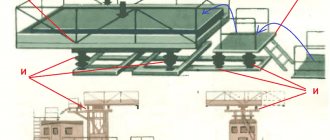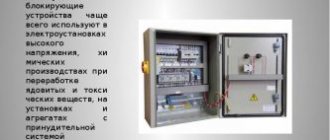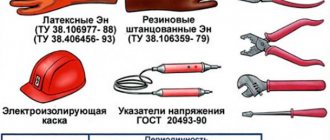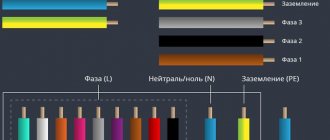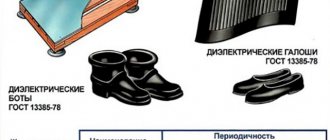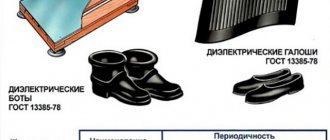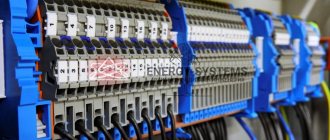How many permits should I issue for working at height in electrical installations?
The main thing in the article
- If the work permit has a mandatory form, it cannot be changed
- To work in electrical installations at height, you can issue one work permit.
- It is not necessary to issue a work permit if work is being carried out to eliminate the accident
- The work permit is drawn up in triplicate if the work order is submitted by telephone
Work at height, as in electrical installations, is considered work with increased danger. For each of them, the manager is required to issue a work permit of the established form. But what to do if an employee must carry out repairs in an electrical installation while at height? How many permit orders do I need to issue?
We issue permits for each type of work
Regulatory legal acts establish that if there is a need to perform work at height in electrical installations, an employee from among the administrative and technical personnel who has the right to issue work orders can issue two separate work permits for each type of work:
- work permit for work at height (issued by an employee trained in the 3rd group on safety of work at height);
- work permit for work in electrical installations (issued by an employee from among the administrative and technical personnel of the organization who has group V - in electrical installations with voltages above 1000 V and group IV - in electrical installations with voltages up to 1000 V).
Thus, the employee issuing the permit must have both of the above qualifications.
Work permit for work at height. It can be completed on a special form, a sample of which is recommended by Order of the Ministry of Labor of Russia dated March 28, 2014 No. 155n “On approval of the Rules for labor protection when working at height” (hereinafter referred to as Order No. 155n). This is the recommended document form. The employer can use it or supplement the form with the necessary information. The permit form that will be used must be approved by local regulations.
The permit for work at height must include the following information:
- place of work at height, its content, conditions;
- start and end times of work;
- the composition of the team and the persons responsible for performing these works.
note
Upon written instructions from the head of the organization, to eliminate an accident or its consequences, an employee from among the operational personnel with electrical safety group IV has the right to issue an order or order. This can be done if there is no employee who has the right to issue permits.
Work permit for work in existing electrical installations. They are drawn up on a special form, a sample of which was approved by Order of the Ministry of Labor of Russia dated July 24, 2013 No. 328n “On approval of the Rules for labor protection during the operation of electrical installations” (hereinafter referred to as Order No. 328n). This is a required form of document. The employer is obliged to use it without changing a single point.
The form indicates information about the place of work and its content, its start and end time, conditions for safe conduct, the composition of the team and employees and those responsible for the safe performance of work.
It is allowed to issue one work permit for the simultaneous or alternate performance of work at different workplaces of the same electrical installation (clause 6.12 of Order No. 328n).
The work permit is drawn up in two copies. If the responsible person transmits the task by phone, radio, fax or email, then you need to write out the order in triplicate.
Permits for work at height and for work in electrical installations are issued for no more than 15 calendar days, with the possibility of being extended once for the same period. They must be stored for 30 days. Except in cases where an industrial accident occurs during work. These squads are handed over to the archive along with the investigation materials (clause 6.5 of Order No. 328n; clause 40 of Order No. 155n).
Rules for filling out permits for electrical installations in 2021
According to Appendix 7 of Order of the Ministry of Labor of Russia No. 328n dated July 24, 2013 “On approval of the Rules for labor protection during the operation of electrical installations,” the work permit for work on electrical installations must be filled out as follows
:
1. Entries in the work permit for work in electrical installations (hereinafter referred to as the work order) must be legible. Filling out the work order with a pencil and correcting the text is not allowed.
2. The numbering system for work orders is established by the management of the organization.
3. When specifying dates, write the day, month and last two digits indicating the year, for example: 09/29/02, 12/19/12, 01/30/13.
4. In addition to the surnames of the workers indicated in the work order, their initials and electrical safety group are recorded.
5. The work order specifies the dispatcher names (designations) of electrical installations, connections, and equipment.
6. If there are not enough lines in the tables of the main form of the order, it is allowed to attach to it an additional form under the same number indicating the surname and initials of the employee issuing the order to continue the entries. In this case, in the last lines of the corresponding table of the main form, you should write: “See. additional form." The additional form must be signed by the employee who issued the order.
7. When filling out the front side of the outfit.
1) in the line “Division” the structural unit (workshop, service, district, site) of the organization in whose electrical installations work is to be performed is indicated;
2) in cases where a responsible work manager is not assigned, the entry “not assigned” is made in the line “Responsible work manager”;
3) in the line “permitting” the surname of the permitting person, appointed from among the operational personnel, or the producer (responsible manager) of the work from among the maintenance personnel, who combines the duties of the permitting person, is indicated. When performing work in electrical installations, where the permitter is an employee from among the operational personnel on duty, the line is written “operational personnel” without indicating the last name;
4) in the line “with team members” the team members performing work in the electrical installation are listed. When performing work using vehicles, mechanisms and self-propelled cranes, it is indicated which member of the team is the driver, crane operator, slinger, as well as the type of mechanism or self-propelled crane on which he works;
5) in the lines “entrusted”:
- for electrical installations of switchgear and cable lines, the name of the electrical installation and its connections in which to work, the content of the work are indicated;
- for overhead lines, indicate the name of the line and the boundary of the area where work is to be done (the number of supports on which or between which, including them, the work will be carried out, individual spans), as well as the content of the work. For a multi-circuit overhead line, the name of the circuit is also indicated, and in case of phase-by-phase repairs, the location of the phase on the support;
6) in the lines “Start work” and “Finish work” the date and time of the beginning and end of work for this work order are indicated;
7) in the table “Measures for preparing workplaces” the following is indicated:
when working in electrical installations of switchgear and cable lines:
- in column 1 - the name of electrical installations in which it is necessary to carry out operations with switching devices and install grounding;
- in column 2 - names (designations) of switching devices, connections, equipment with which operations are carried out, and places where grounding should be installed.
Disconnections in secondary circuits, in relay protection devices, electrical automation, telemechanics, and communications are not required to be indicated in this table;
when working on overhead lines:
- in column 1 - the names of lines, circuits, wires written in the “assigned” line of the work order, as well as the names of other overhead lines or circuits that are subject to disconnection and grounding in connection with the performance of work on the overhead line or circuit being repaired (for example, overhead lines intersecting with the line being repaired or other circuits of multi-circuit overhead lines passing near it);
- in column 2 - for overhead lines that are disconnected and grounded by an authorized member of the operating personnel - the name of the switching devices in the switchgear and on the overhead line itself with which operations are carried out, and the numbers of the supports on which grounding must be installed.
The same column must indicate the numbers of supports or spans where the workman must install grounding wires and cables at the workplace in accordance with clauses 22.2, 22.6, 22.8, 22.10, 22.12 of the Rules.
If the installation locations of grounding cannot be determined when issuing the work order or the work will be carried out with rearrangement of grounding, the column indicates “Ground at workplaces”;
in column 2 - places where the workman must install grounding on the overhead lines that intersect with the one being repaired or passing near it. If these overhead lines are operated by another organization (service), the work order line “Separate instructions” must indicate the need to check the groundings installed by the personnel of this organization (service).
The table “Measures for preparing workplaces” should include those operations with switching devices that are needed to prepare the workplace itself. Switchings performed during the preparation of the workplace associated with changes in schemes (for example, transfer
connections from one bus system to another, transfer of power to a network section from one power source to another), are not recorded in the table.
For work that does not require preparation of the workplace, the entry “Not required” is made in the columns of the table;
 In the line “Special instructions” the following is indicated:
In the line “Special instructions” the following is indicated:
- additional measures to ensure the safety of workers (installation of fences, checking the air in the room for the absence of hydrogen, fire safety measures;
- stages of work and individual operations that must be performed under the continuous control of the responsible work manager, in accordance with clause 5.7. Rules;
- in case of registration of a work order for an observer - the surname and initials of the responsible employee leading the team, in accordance with clause 5.10 of the Rules;
- permission to the responsible manager and work manager to transfer workers to another workplace, in accordance with clause 12.1. Rules;
- permission to the work contractor (supervisor) to re-admit, in accordance with clause 13.3 of the Rules;
- permission to turn on the electrical installation or part of it (individual switching devices) without permission or order from the operating personnel, in accordance with clause 15.2 of the Rules;
- permission to temporarily remove groundings in accordance with clauses 21.5 and 39.12 of the Rules;
- permission for the work contractor to operate switching devices in accordance with clause 43.2 of the Rules;
- responsible employees for the safe performance of work with cranes (lifts) in accordance with clause 45.3 of the Rules);
- an indication that the line being repaired is located in the zone of induced voltage from another overhead line, in accordance with clause 38.43 of the Rules;
- additional requirements for safety measures when working in the zone of influence of electric and magnetic fields in accordance with clause 24.18 of the Rules;
- an indication of the need to check the grounding of overhead lines of other organizations, paragraph 7) of the notes of the Appendix;
- an indication that the substation equipment (dispatch names are indicated) is located in the induced voltage zone;
- permission for the work contractor to test switching devices in accordance with clause 28.7 of the Rules.
- The issuer of the order is allowed to make, at his discretion, other entries related to the work performed in these lines;
9) in the lines “Issued the order” and “Extended the order,” the employee issuing the order indicates the date and time of its signing.
Employees issuing and renewing work orders must indicate their last name in addition to their signature;
10) in the table “Permission to prepare workplaces and for permission to perform work”, filled out when obtaining permission to prepare a workplace and initial permission to work, the following is indicated:
- in column 1 - workers preparing workplaces and permitting indicate the positions and names of workers who issued permission to prepare workplaces and for permission to perform work (hereinafter referred to as the permission). When handing over permits in person, column 1 is signed by the employees issuing the permit, indicating their position;
- in column 2 - date and time of issue of the permit;
- in column 3, employees who received permission sign. When preparing workplaces by several employees or employees of different workshops, column 3 is signed by everyone who prepared the workplaces.
If permissions are not requested at the same time, then in the table “Permission to prepare workplaces and for permission to perform work” two lines are filled in: one for permission to prepare a workplace, the other for permission for permission to work.
8. When filling out the back of the order:
1) when working in switchgear and on cable lines in the line “Workplaces are prepared. Remained under voltage”, allowing indicates the names of the remaining live parts of the repaired and adjacent connections (or equipment of adjacent connections) closest to the workplace.
When working on overhead lines, these lines record the names of live parts indicated by the worker issuing the work order in the “Separate instructions” line on the front side of the work order, and, if necessary, the names of other live parts.
The permitting and responsible work manager (the work supervisor observing, if a responsible manager has not been appointed) sign under the line “Workplaces are prepared. “Remained under voltage” only upon initial approval to perform work;
2) in the table “Daily admission to work and time of its completion” information is indicated on daily admission to work and the date and time of its completion, including admission upon transfer to another workplace.
If the work foreman combines the duties of the permitter, and also if the work foreman is allowed to re-admit the team to perform work, he signs in columns 3 and 4.
When the responsible work manager is allowed to re-admit the team to work, he signs in column 3.
The completion of work associated with the end of the working day is recorded by the work manager (supervisor) in columns 5 and 6;
3) in the table “Changes in the composition of the brigade” the surname, initials, electrical safety group of the brigade members added and removed from its composition are indicated; surname, initials of the employee who authorized changes in the composition of the team, secured by his signature). When adding a car driver, a machine operator or a crane operator to or from a team, the type of car, mechanism or self-propelled crane assigned to him is also indicated.
When transmitting permission by telephone or radio, the work manager indicates the name of the employee in column 4;
in the line “The work is completely completed, the team has been removed, the groundings installed by the team have been removed, reported (to whom)” indicates the position, surname, initials of the person who received the information.
4) After complete completion of the work, the work foreman (supervisor) and the responsible work manager sign in the appropriate lines of the work order, indicating the date and time of complete completion of the work. If a responsible work manager has not been appointed, then the signature in the line “Responsible work manager” is not placed.
If, during the execution of the complete completion of work in the work order, there are no operational personnel or a permitter from among the operating personnel, or the work manager combines the duties of a permitter, the work performer or supervisor formalizes the complete completion of the work only in his copy of the work order, indicating the position and surname of the employee to whom he informed about the complete completion of the work. completion of work, as well as the date and time of the message.
If, during the execution of the complete completion of the work, operational personnel or an admitting member of the operational personnel are present, the work performer or supervisor formalizes the complete completion of the work in both copies of the work order.
If the team did not install groundings, then the words “groundings installed by the team have been removed” are crossed out from the text of the message.
9. Before the team is authorized to work on the work order, targeted briefings must be carried out by the issuer of the work order and the permitter, and before the start of work - by the responsible manager (work manager, supervisor) with their registration in the appropriate tables for registering the target briefing carried out by the issuer of the work order, in the work order form . Conducting targeted briefings should cover all workers involved in the work - from the person who issued the work order to the team members.
The signatures of employees in the registration tables for targeted briefings are confirmation of the conduct and receipt of the briefing.
The permit is issued in accordance with the form of Appendix 7 of Order No. 328n of the Ministry of Labor of Russia dated July 24, 2013
A blank permit form for work on electrical installations from our portal
We issue a general permit for two types of work
The order of the Ministry of Labor of Russia dated March 28, 2014 No. 155n “On approval of the Labor Safety Rules when working at height” states that if work at height is carried out simultaneously with other types of work that require a permit, then the employer has the right to issue one work permit. But it is imperative to include information about work at height and the employees who are appointed responsible for the safe performance of work.
In this case, the permit form for work in electrical installations is mandatory for use. This means that you need to draw up exactly this document and include additional requirements for organizing work at height in the “Separate instructions” line.
The employer can use any of the proposed options. Both are legal. But it is worth considering that the choice of methods of lifting to heights and the elements of insurance for workers must be carried out taking into account the use of non-conducting materials.
Mandatory and recommended permitsWork with increased danger should only take place after a permit has been issued. Typical samples can be found in the regulations on work with increased danger (POT RO 14000-005-9) and various regulations. For example: - in the order of the Ministry of Labor of Russia dated June 1, 2015 No. 336n “On approval of the Rules for labor protection in construction”; — Order of the Ministry of Labor of Russia dated July 7, 2015 No. 439n “On approval of the Rules for labor protection in housing and communal services”; - Order of Roskomtorg dated June 28, 1993 No. 44 “On approval of labor protection rules in commercial warehouses, bases and refrigerators” and other documents. Standard samples specified in regulatory documents may be recommended or mandatory. In the first case, the normative act states that the form is recommended. Then the employer is not obliged to use this particular form. He can develop a more convenient sample at the enterprise based on the one presented. In the second case, the employer is obliged to use this particular form without changing it. |
Shelf life of permit for work at height
Work orders are stored for 30 days, then they can be destroyed (clause 60 of the Rules for Work at Heights). But if any incident occurred during the execution of work, then it must be stored along with the investigation materials for 45 years.
Storage periods are regulated by Rosarkhiv Order No. 236 of December 20, 2019, this is an important point, because even after ten years, you may only need one training protocol or a timely prepared report, so read this order and be sure to be guided in your work.
